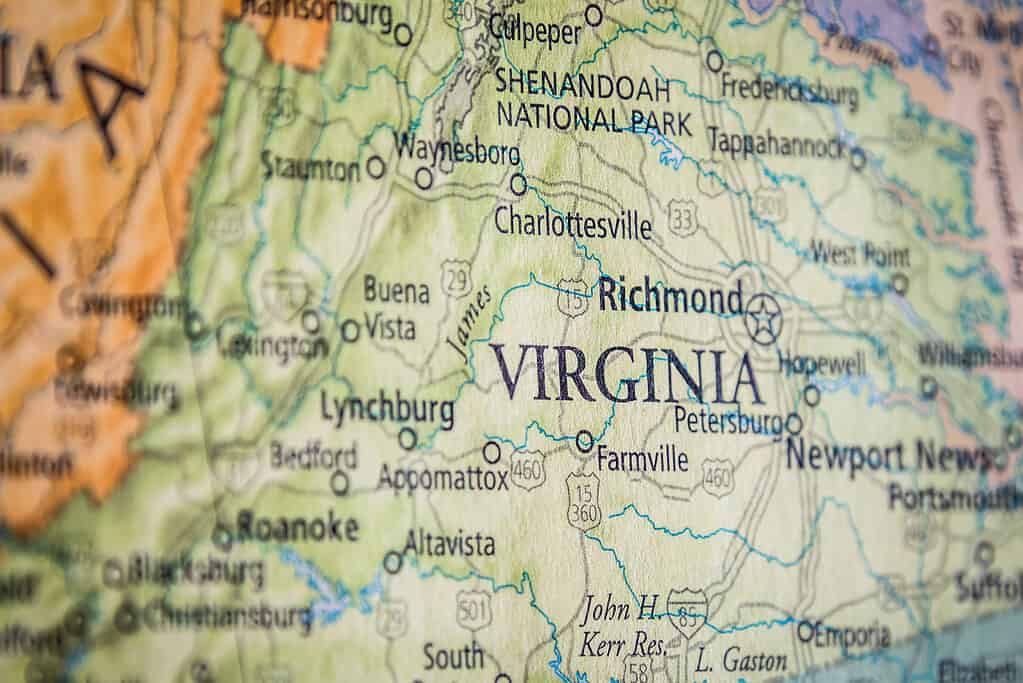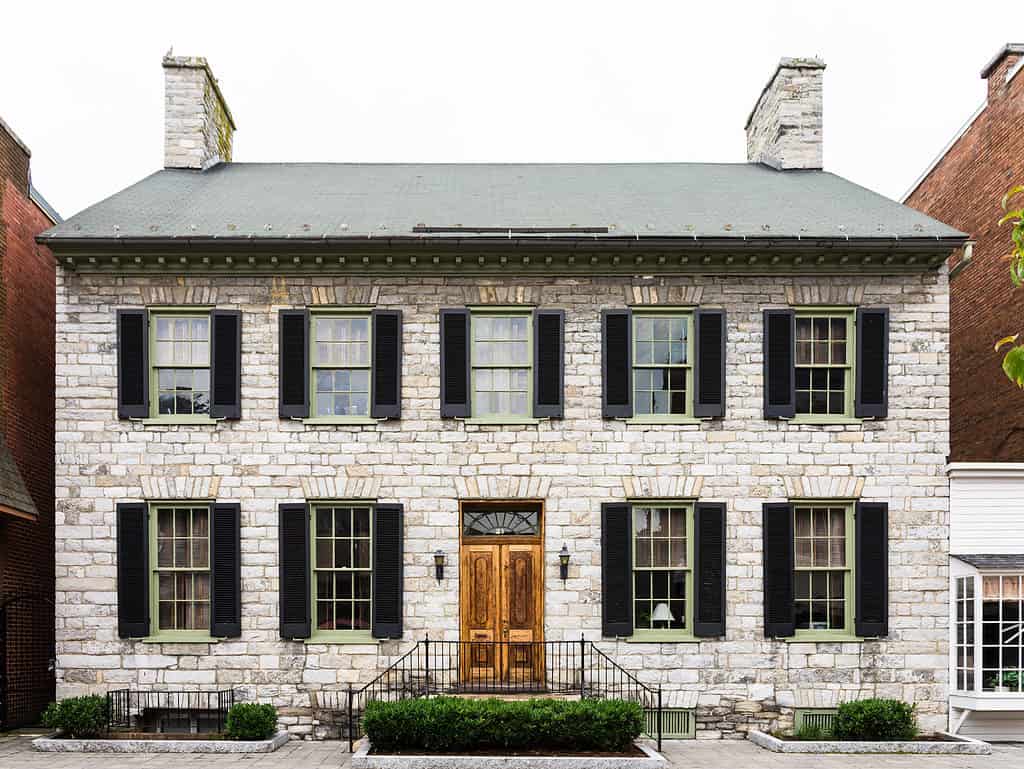For hundreds of years flags have been used as symbols all around the world. They are used to distinguish places or groups using their bright colors and various shapes and symbols. Quite often, they are steeped in history and can tell a tale of the history of the country. Or, in other cases they can act as a beacon of hope and a rallying symbol. But what about the flag of Virginia, what does it symbolise? Join us as we discover its history and exactly what it represents.

Officially named the Commonwealth of Virginia, Virginia is one of the thirteen original colonies that joined the United States.
©BestStockFoto/Shutterstock.com
A Brief History of Virginia
Officially named the Commonwealth of Virginia, Virginia is one of the thirteen original colonies that joined the United States. Virginia joined in 1788 as the tenth US state. However, Virginia was divided during the Civil War when the state government joined the Confederates but many counties in the northwest remained loyal to the Union. These counties then split off in 1863 to form West Virginia.
Statehood aside, the Colony of Virginia was formed in 1606 and was the first permanent English colony in what is now the US. The area was managed by the Virginia Company — under the guise the London Company – on behalf of King James I. Eventually, in 1624 the Virginia Company was dissolved by the king. Following this, Virginia was made a royal colony with the colonists allowed to self-govern the area. Many colonies were loyal to the king during the English Civil War and many Royalists fled to Virginia from England. In honor of Virginia’s loyalty the king gave it the nickname “Old Dominion”, which it still bears today.
Although Virginia was one of the largest and most influential colonies, it saw decades of conflicts between the English settlers and the native tribes. Eventually, following more Indian wars, an effort by the English to introduce new taxes led to the monarchy becoming deeply unpopular with those living in Virginia. Virginia then subsequently began to coordinate with other colonies to take steps to seek independence. Independence from the English rule was successfully achieved in 1776, just a few years before Virginia achieved statehood.

Statehood aside, the Colony of Virginia was formed in 1606 and was the first permanent English colony in what is now the US.
©Brett Taylor Photography/Shutterstock.com
History of the Flag of Virginia
The current flag of Virginia consists of a dark blue field with the obverse side of the state seal in the centre. It was adopted in 1912 and closely resembles the flag that was adopted in 1861 at the beginning of the American Civil War. Prior to 1861 the state seal had been featured on the flags of several Virginian military regiments, albeit on a plain white background.
The Virginia state seal was adopted in 1776 and has designs on both sides. The obverse side is the side that is featured on the flag as well as used on all official state documents. The seal was created just a few months after Virginia became independent from Great Britain. It was specifically designed in such a way as to not resemble a coat of arms as coats of arms were often used as distinguishing symbols by Britain. Instead, the design was influence by Ancient Roman mythology on both sides.
The seal features a female figure standing over a fallen king and has a partially exposed breast — making it the only state flag that depicts any form of nudity. The name of the state is above the figure, while below is the state motto, “Sic semper tyrannis”. Bordering the seal is a wreath of Virginia creeper.

Prior to 1861 the state seal had been featured on the flags of several Virginian military regiments, albeit on a plain white background.
©Sean Pavone/Shutterstock.com
Symbolism and Meaning
The image on the state seal is both fascinating and extremely symbolic. For a start, the female represents virtus which was a virtue in Ancient Rome. She is dressed as an Amazon and wears a helmet. She also holds a spear and a sword. The fallen king at her feet is Tyranny and he holds a broken chain in his left hand and whip in his right, while his crown lies beside him.
The way that the two figures are presented symbolises the defeat of Britain at the hands of Virginia. The fallen crown represents Virginia’s release from a tyrannical government, as does the whip that has been rendered useless. The broken chain symbolises Virginia’s release from Britain’s hold over colonial trade and the westward expansion. Furthermore, as Virtus’ sword is sheathed it is widely regarded as a sword of authority rather than combat, making her a peaceable figure.
Finally, the state motto “Sic semper tyrannis” when translated means “Thus always to tyrants”. It is a Latin phrase that means that tyrannical leaders will always be defeated and overthrown. It is derived from a Roman quote that is attributed to Brutus following the slaying of Caesar.
State Seal (Reverse Side)
Although the reverse side of the state seal does not feature on the Virginia state flag we thought it was worth mentioning the images depicted on it anyway. The reverse side features three Roman goddesses. To the left is Ceres — the goddess of agriculture. She is holding a horn of plenty in her left hand and a sheaf of wheat in her right hand. In the centre is Libertas — the goddess of individual liberties. She holds a wand to represent her magical capabilities and at the top of the wand is a liberty cap. To the right is Aeternitas who is the personification of liberty. She holds a golden ball which represents authority and on top of the ball is a phoenix which represents immortality.
The reverse of the seal also features a motto, Perseverando, which when translated means “persevering”. It is intended as a reminder of the need to maintain the blessings of liberty.
Up Next
- Every Flag in the World: Photos, History, and More
- The Flag of Kansas: History, Meaning, and Symbolism
- The Flag of Arizona: History, Meaning, and Symbolism
The photo featured at the top of this post is © Mehaniq/Shutterstock.com
FAQs (Frequently Asked Questions)
What is interesting about the State of Virginia's seal?
The seal features a female figure standing over a fallen king and has a partially exposed breast — making it the only state flag that depicts any form of nudity.
When was the state seal adopted?
The Virginia state seal was adopted in 1776 and has designs on both sides. The obverse side is the side that is featured on the flag as well as used on all official state documents. The seal was created just a few months after Virginia became independent from Great Britain. It was specifically designed in such a way as to not resemble a coat of arms as coats of arms were often used as distinguishing symbols by Britain. Instead, the design was influence by Ancient Roman mythology on both sides.
Thank you for reading! Have some feedback for us? Contact the AZ Animals editorial team.







